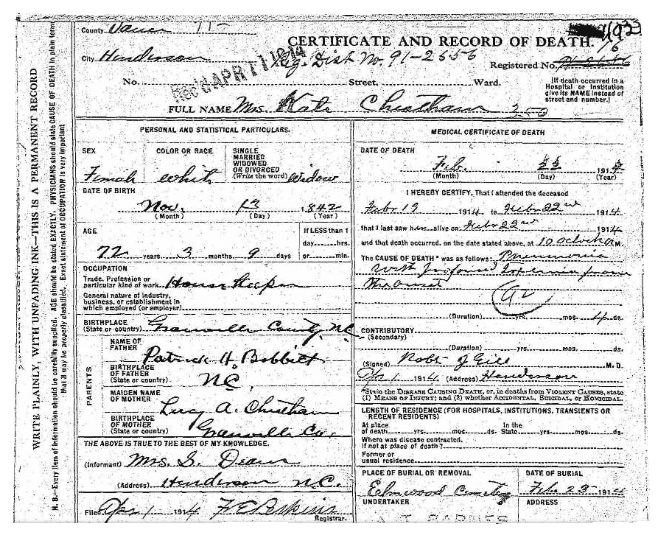Introduction: In this article – part of an ongoing “Introduction to Genealogy” series – Gena Philibert-Ortega discusses how helpful death certificates can be for your family history research, and suggests places where death certificates can be found. Gena is a genealogist and author of the book “From the Family Kitchen.”
Most likely one of the first family history documents you learned about was a death certificate. In the best of cases a death certificate reports on the death of an ancestor and provides clues to their life. As with any document, it’s important to understand how to find what you need and what it’s telling you.

Why Death Certificates?
Researching your ancestor’s death should be one of the first to-dos on your genealogical checklist. Why? In family history research, always start your research with the most recent event (the ancestor’s death) and work backward through their life. After you find your ancestor’s death date, work on proving their children’s relationship to them, next find the marriage record, then connect your ancestor to their own parents.
Death certificates are relatively more recent documents, depending on where you are researching, so one may not have been produced for your ancestor’s death. But it’s important to gather the ones that are available and analyze the information they provide.
The First Resource, but Not Necessarily the Most Accurate
When you can find one, a death certificate seemingly has all the information you need, from birth date, parental names, death date and place, cause of death, and burial site – to the deceased’s street address, occupation, and marital status. What more could you want? Well, as with everything that seems too good to be true, there’s a caveat.
Death certificates have information that is provided by multiple informants – and some of it might not be entirely accurate. So, for example, a physician might provide the cause of death. A family member or friend might provide information about the deceased such as their occupation, birth date, and their parents’ names.
It’s important to remember that numerous factors can influence the accuracy of the personal information that appears on a death certificate. Family members are understandably upset when they provide the information for the death certificate, or they may not know the correct answers to the questions being asked. Unless the informant is an older family member or a parent, they weren’t there for the birth of the deceased so their answers should be carefully considered. Even in cases where the person gives correct information it can be transcribed incorrectly on the certificate.
Genealogy Tip: Although death certificates can be wonderfully helpful family history documents, cross-check them with other records to verify the information.
Who Has a Death Certificate?
Obtaining a government-issued vital record may seem like an obvious step in documenting your ancestor, but the simple truth is that not everyone’s death is recorded – and if your ancestral line traces back to the early days of our nation, you will come to a point where a vital record will not be an option. We’ll explore vital record alternatives later in this “Introduction to Genealogy” series, but for now – just know that if you are researching someone who died prior to vital record registration, you need to search for an alternative source like a church record or newspaper article (such as an obituary or probate notice).
It’s important to know when vital record registrations began for the state your ancestor died in, as it varied from state to state. It’s equally important to know if that registration occurred earlier for a larger city or county within that state. A state may have required death registration years after counties or large cities were already documenting these events. The chart below provides a guideline to when death registration occurred on the state level.
Date of Required State Death Certificates
| Alabama 1908 | Alaska 1913 | Arizona 1909 | Arkansas 1914 | California July 1905 |
| Colorado 1907 | Connecticut 1897 | Delaware 1881 | Florida 1899 | Georgia 1919 |
| Hawaii 1859 | Idaho 1911 | Illinois 1916 | Indiana 1899 | Iowa 1880 |
| Kansas 1911 | Kentucky 1911 | Louisiana 1914 | Maine 1892 | Maryland 1898 |
| Massachusetts 1841 | Michigan 1867 | Minnesota 1908 | Mississippi 1912 | Missouri 1910 |
| Montana 1907 | Nebraska 1905 | Nevada 1911 | New Hampshire 1901 | New Jersey 1848 |
| New Mexico 1920 | New York 1880 | North Carolina 1913 | North Dakota 1907 | Ohio 1908 |
| Oklahoma 1908 | Oregon 1903 | Pennsylvania 1906 | Rhode Island 1853 | South Carolina 1915 |
| South Dakota 1905 | Tennessee 1908 | Texas 1903 | Utah 1905 | Vermont 1857 |
| Virginia 1853 | Washington July 1907 | West Virginia 1917 | Wisconsin 1907 | Wyoming July 1909 |
Source: FamilySearch
Please note that some counties started recording deaths much earlier than their parent state. So always check the county your ancestor died in. In some cases, states did not start registering deaths on January 1st so the year quoted above might be only partial years. Interruptions (like war) can also occur with vital record registration, leaving some deaths not recorded. The District of Columbia started vital records registration in 1855.*
Where Are Death Certificates?
You’ve got the information you need to look for a death certificate, so where do you find the death certificate for your ancestor?
Start by searching the FamilySearch Catalog. FamilySearch has vital records on microfilm and through their Records collection. If they do not have what you need, check digitized images available from subscription genealogy websites. In some cases, older vital records are kept in a county or state archive. Remember, not everything is online – so make sure you seek out information about the county you are researching. To learn more about death records, see the FamilySearch Family History Research Wiki page for the state and county you are researching.
If you need to order a death certificate, always try to obtain it from the county where the death occurred. Often this can mean less time waiting for your certificate copy. Search online by typing the county you are interested in and the phrase “vital records.”
Please note that in some cases there is more involved in ordering a certificate than just simply filling out a form and sending payment. Counties are different, even within the same state. Some may require a government-issued ID or a signed notary statement. In some cases, there are restrictions on who can request a certificate or what years can be requested.
You may have a choice of what type of certificate you receive. For example, in California you can choose a certified copy or an information copy. However, the certified copy is only available to certain people. Everyone else gets an information copy that is not only redacted but includes a large black stamp across the record indicating that is an information copy.
Start Searching for Death Certificates
Do you have death certificates for your more recent ancestors? Have you looked to see what you are missing? Who should have a death certificate that you need to look for? Remember that a death certificate is just one way to document a death. Learning about your ancestor’s death means not just obtaining the records, but really analyzing what they are telling you and then proving or disproving the clues they hold.
——————————–
* Vitalrec.com; FamilySearch Family History Research Wiki; Family Tree Magazine Vital Records Chart https://mail.google.com/mail/u/0/#inbox/1581dca03d2195ad?projector=1
Related Articles:
